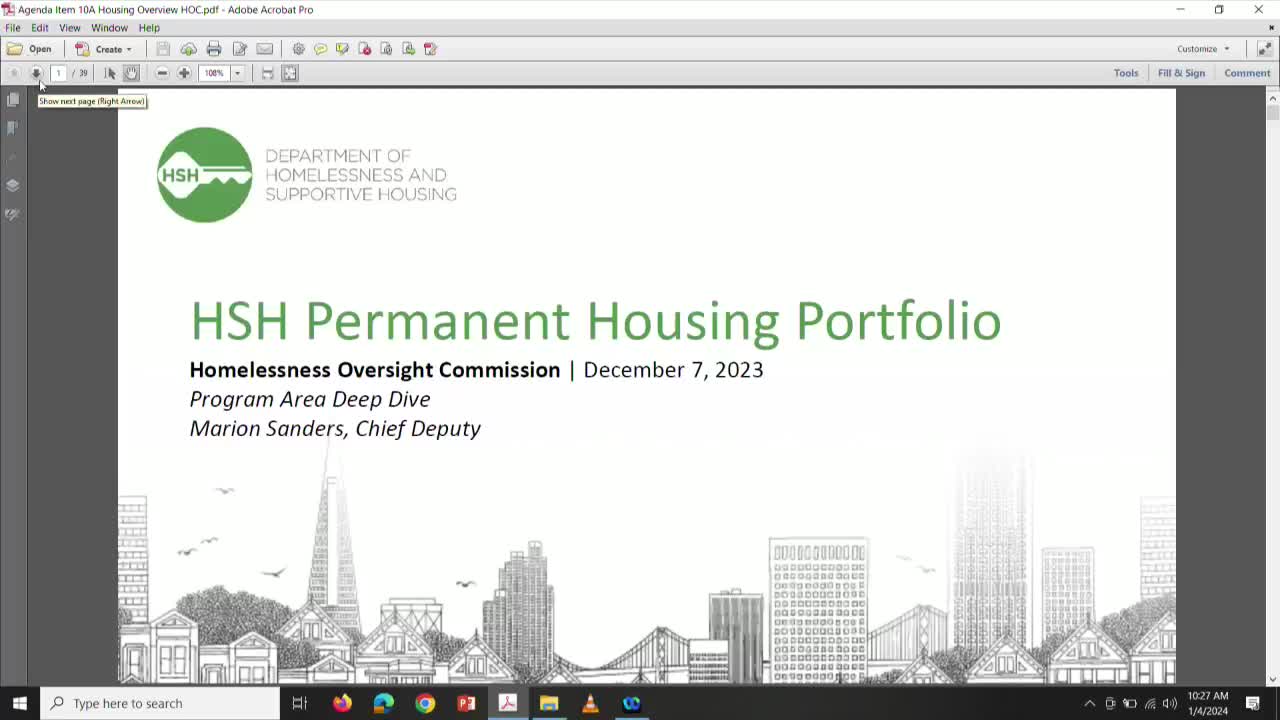Housing Commission details strategic plan to combat homelessness in the city
January 04, 2024 | San Francisco City, San Francisco County, California

This article was created by AI summarizing key points discussed. AI makes mistakes, so for full details and context, please refer to the video of the full meeting. Please report any errors so we can fix them. Report an error »

The City of San Francisco held a government meeting on July 4, 2025, focusing on the Department of Homelessness and Supportive Housing (HSH) and its permanent housing portfolio. The presentation aimed to provide a comprehensive overview of the city's strategic plan and housing initiatives aimed at addressing homelessness.
The meeting began with an introduction to the HSH's strategic plan, which outlines five main goals. These include reducing homelessness by 50% among sheltered individuals and by 15% overall, addressing racial inequities in homelessness experiences, supporting at least 30,000 individuals in transitioning from homelessness to permanent housing, and ensuring that those who exit homelessness do not return.
The HSH housing portfolio consists of four key components: site-based permanent supportive housing, scattered site permanent supportive housing, rapid rehousing, and the housing ladder. Each component serves various populations, including adults, families, veterans, and the chronically homeless.
Site-based permanent supportive housing offers long-term affordable housing with on-site social services, totaling 9,064 units. Scattered site supportive housing provides long-term subsidized housing in the private market, with a capacity of 2,057 units. Rapid rehousing offers time-limited subsidies and supportive services, accommodating 1,719 units. The housing ladder program allows residents to transition to more independent living with light-touch case management, with a capacity of 356 units.
The presentation also highlighted the differences between site-based and scattered site housing, emphasizing the importance of housing navigation services and case management for tenants in both models. Key performance measures for the housing portfolio were discussed, focusing on housing retention, successful move-ins, and tenant satisfaction.
Financially, the adopted budget for fiscal years 2023-2025 allocates nearly $800 million, or 59% of the budget, to housing services and subsidies. This includes funding for expanding permanent housing, operational support for newly constructed units, and quality improvements across the housing portfolio. The majority of funding comes from local sources, with a smaller percentage from state and federal funds.
The meeting concluded with a discussion on the estimated annual operating costs for supportive housing, which range from approximately $40,000 to $65,000 per adult or family, depending on the housing type. The HSH plans to continue refining its performance measures and will provide further updates in future presentations.
The meeting began with an introduction to the HSH's strategic plan, which outlines five main goals. These include reducing homelessness by 50% among sheltered individuals and by 15% overall, addressing racial inequities in homelessness experiences, supporting at least 30,000 individuals in transitioning from homelessness to permanent housing, and ensuring that those who exit homelessness do not return.
The HSH housing portfolio consists of four key components: site-based permanent supportive housing, scattered site permanent supportive housing, rapid rehousing, and the housing ladder. Each component serves various populations, including adults, families, veterans, and the chronically homeless.
Site-based permanent supportive housing offers long-term affordable housing with on-site social services, totaling 9,064 units. Scattered site supportive housing provides long-term subsidized housing in the private market, with a capacity of 2,057 units. Rapid rehousing offers time-limited subsidies and supportive services, accommodating 1,719 units. The housing ladder program allows residents to transition to more independent living with light-touch case management, with a capacity of 356 units.
The presentation also highlighted the differences between site-based and scattered site housing, emphasizing the importance of housing navigation services and case management for tenants in both models. Key performance measures for the housing portfolio were discussed, focusing on housing retention, successful move-ins, and tenant satisfaction.
Financially, the adopted budget for fiscal years 2023-2025 allocates nearly $800 million, or 59% of the budget, to housing services and subsidies. This includes funding for expanding permanent housing, operational support for newly constructed units, and quality improvements across the housing portfolio. The majority of funding comes from local sources, with a smaller percentage from state and federal funds.
The meeting concluded with a discussion on the estimated annual operating costs for supportive housing, which range from approximately $40,000 to $65,000 per adult or family, depending on the housing type. The HSH plans to continue refining its performance measures and will provide further updates in future presentations.
View full meeting
This article is based on a recent meeting—watch the full video and explore the complete transcript for deeper insights into the discussion.
View full meeting
